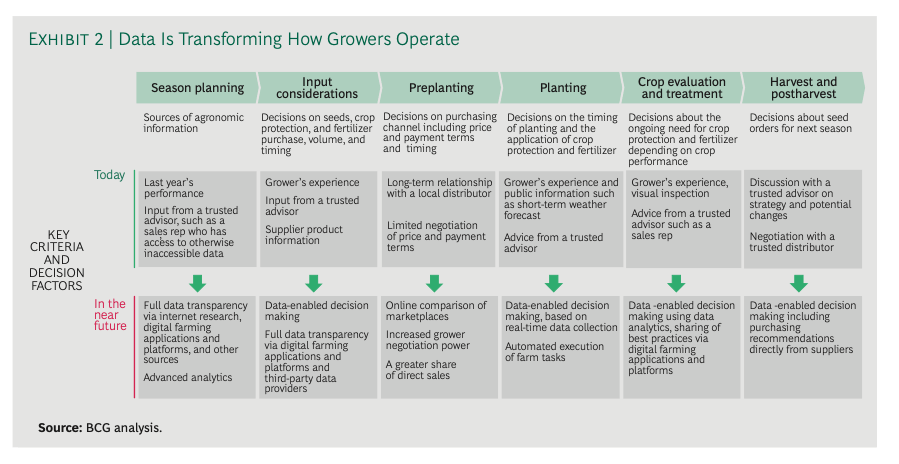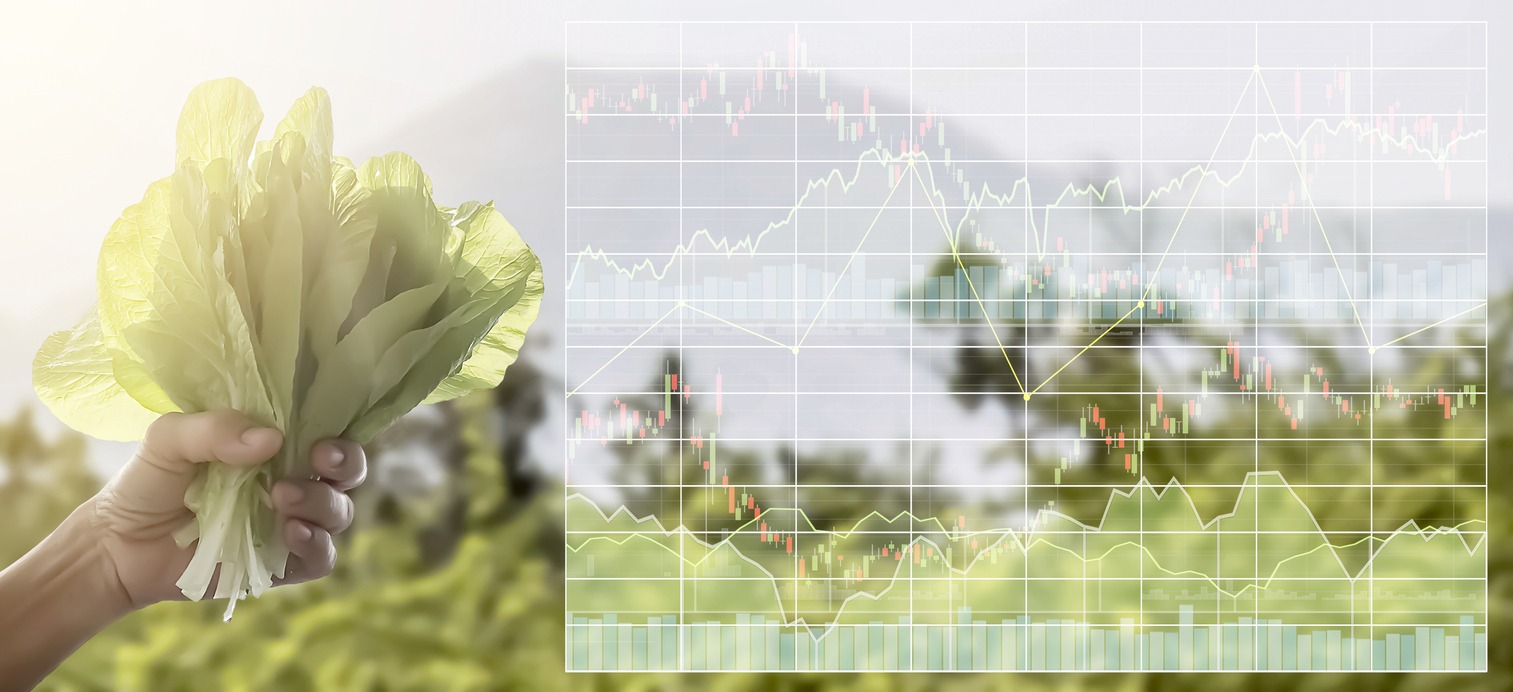Data is transforming the entire agriculture value chain. Growers are collecting, processing and analyzing data to maximize their yields and reduce the need for agricultural inputs and natural resources. New digital tools are enhancing transparency into how crops are grown, livestock is produced, and food is processed and distributed, satisfying consumers’ and regulators’ demand for more information about the food we eat.
But the agricultural-input suppliers that provide seeds, fertilizers, and chemical crop protection to farmers have not yet taken full advantage of data and the new digital tools to get closer to growers and boost sales. These companies have a wealth of data on the performance and value of their products, but they know little about the growers who actually use their products
Meanwhile, competition is tightening as the agriculture inputs industry consolidates and new technology-oriented companies are moving into the agriculture market with digitally-enabled business models designed to provide greater transparency into performance and prices, and respond faster and more directly to growers’ needs.
If input suppliers are to continue to compete successfully, they must develop new go-to-market strategies that maximize their use of data to gain insight into their markets and customers and provide them with fully customized products and services. And they must act fast because the rapidly increasing use of data will quickly sort out the winners from the losers in the agricultural-input supply business, as it has in so many other industries.
An industry disrupted
Three factors are forcing input suppliers to rethink their go-to-market strategies. First, the digital revolution is finally transforming the agriculture industry, transforming every link in the agricultural supply chain. Growers are taking advantage of better data on weather, climate, location technology, soil and crop conditions, pricing, distribution, and retailer and customer demands. (See Exhibit 2.) In response, agricultural-input suppliers are beginning to rethink how to support farmers’ efforts to balance yield, resource management, and consumer expectations.

The increased interest in data-enabled farming and related services is also blurring the boundaries between agricultural-supply sectors such as seeds, crop protection, fertilizers, equipment, and distribution. New entrants from the technology industry as well as nimble startups are already looking to change the competitive landscape.
Second, companies are combining forces to develop fully integrated operations and thereby build scale, improve flexibility and variability in their operations, and lower costs. This trend is raising the competitive bar for all input suppliers. Many large-scale mergers have occurred, particularly in the seed and crop protection sectors. Newly combined companies such as Corteva (the agriculture division of DowDuPont), ChemChina and Syngenta, Bayer and Monsanto, and BASF (which bought parts of Bayer’s Crop Science division) will likely control an even larger share of the business in the future.
Meanwhile, growers are facing rising pressure from regulators and consumers to use the land, water, energy, fertilizers, and crop protection chemicals that go into agricultural production in a more sustainable and environmentally conscious way. And consumers, particularly in developed markets, are demanding healthier, safer, more nutritious food. Farmers must now meet stricter quality and transparency targets for enhanced nutritional value and taste as well as lower levels of crop protection residue.
Getting closer to customers
By understanding growers’ new needs and expectations, agricultural-input suppliers can serve them far more effectively and profitably than in the past. To do so, however, they must gather detailed data on their customers and analyze it to produce meaningful and valuable business insights. Then they must use these insights to develop more-customer-centric products and customize product offerings to the needs of individual farms.
Agricultural-input suppliers that don’t get these things right or move too slowly face considerable risks. Faster-moving, digitally sophisticated rivals and third-party providers could step in between suppliers and their customers, outcompeting the more traditional players. And better data on—and improved transparency into—the effectiveness of particular products will raise the bar for all agricultural-input products.
How to Pioneer the Change
Equipped with a better understanding of the evolving needs of growers, suppliers must build efficient, digitally enabled go-to-market organizations. To do so, they need to rethink three key aspects of their customer-facing activities—marketing, sales, and pricing—and then integrate all three into a comprehensive end-to-end program.
Data-driven marketing. Every go-to-market strategy, old or new, depends on gaining the best possible understanding of customer needs and expectations. The digital revolution in marketing now enables companies to capture and effectively use information to segment customers precisely and accurately and then customize their approach to each segment.
The first step is to actively seek the most relevant customer information possible—including past experience, point-of-sale data, and farm-specific demand data and sources such as social media and online research about customer concerns, complaints, likes, and dislikes—and use it to support the customer segmentation process. Once captured, this information can be used to create a comprehensive marketing program including recommendations for crop protection products and when to apply them and seed choices depending on soil and environmental conditions.
Digitally enabled sales leads that are based on customer information can significantly increase the success rate and productivity of the sales force.
The digitally enabled sales force. Once captured, customer date should be used to design individualized sales experiences that maximize the impact on sales results. A properly designed sales journey requires the clear definition and integration of the sales force’s functions and roles to ensure a consistent message and higher customer satisfaction. And it must include both traditional and digital sales channels so that the go-to-market strategy is fully interlinked across channels and integrated into a single holistic approach.
Online sales channels with optimized connections to traditional offline channels can enhance the interaction between the customer and the sales force, provided the channels are properly designed and include detailed knowledge about customer needs. By tracking customers throughout the online sales journey and analyzing their responsiveness and value to the company, the sales force can make continual improvements to the sales experience.
Soon, analysis of customer needs, augmented by artificial intelligence, will enable suppliers to further customize seed, fertilizer, and crop protection recommendations and even predict customers’ input needs by using data from prior years. This in turn will empower the sales force to maintain better contact with growers, increasing loyalty and value for both suppliers and their customers.
Next-generation pricing. Prices should no longer be determined at the corporate level. The key to pricing success lies in providing the sales force with flexible pricing tools they can use to make the best offers at the most opportune time. Value-based pricing mechanisms allow the sales force to determine prices using the actual value the product creates in the field. Simulation tools can give the sales force a clearer understanding of the impact of pricing levels on volume and profitability, providing the data needed to make real-time pricing decisions both online and in the field.
By using pricing data combined with detailed information about individual customers, the sales force can strike the best balance between volume and price at each stage of the customer journey and track the effect of price on customer profitability over time.
Conclusion
The key to success in the agricultural-inputs business, as in any business, lies in understanding the needs and expectations of customers, creating innovative products and services that best fulfill those needs, and taking them to market effectively. Every supplier understands that there is considerable value to be captured by leveraging data and digital tools to get closer to customers and to better meet their needs. The only question that remains is: Which companies can attain that goal first, and which will be left behind?
Find the full research from BCG here.
About the Authors
Jan-Frederik Jerratsch is a principal in the Berlin office of The Boston Consulting Group and an expert on agribusiness topics worldwide. You may contact him by email at [email protected].
Torsten Kurth is a senior partner and managing director in the firm’s Berlin office and a co-leader of the global agriculture topic. You may contact him by email at [email protected].
Gerd Wübbels is a partner and managing director in BCG’s Frankfurt office and an expert in the global agriculture topic. You may contact him by email at [email protected].
Decker Walker is a partner and managing director in the firm’s Chicago office and a co-leader of the global agriculture topic. You may contact him by email at [email protected].




